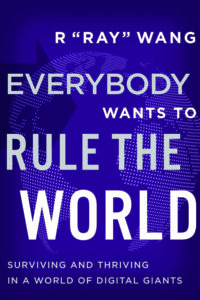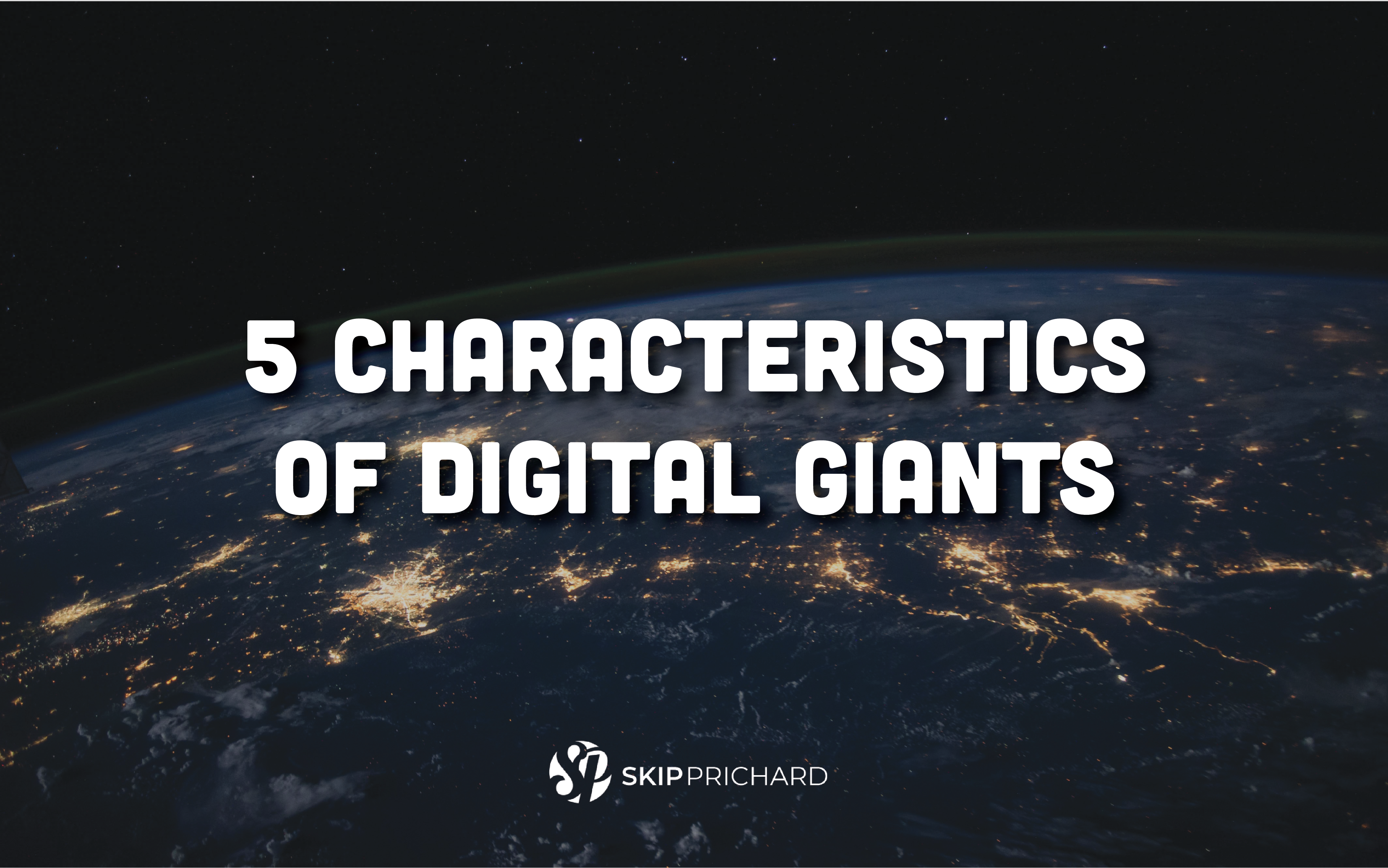Rule the World
How is extreme consolidation changing global business?
What are the most innovative companies doing to position themselves?
How do you become a market leader in the midst of rapid change?
Ray Wang is the Founder of Constellation Research, Inc. and has studied emerging business and technology trends. His columns are read by millions, and he is a frequent keynote speaker at some of the major tech conferences. His new book, Everybody Wants to Rule the World: Surviving and Thriving in a World of Digital Giants is a compelling book for leaders thinking about strategy and positioning their companies for what’s next.
You predict that we will have only 100 dominant players in 50 markets by 2050. What are some of the dynamics at play causing this?
At the macro level, short-term EBIDTA optimization board room mindsets, the shareholder investor quest for outsized returns, and the reality that digital transformation is not enough have led to the conditions for digital giants to emerge. Let’s start with the short-term mindset. Most established companies focus on short-term financial metrics geared towards shareholder returns. In fact, many of their leaders have forgotten how they got there – mission, talent, offering, and markets. They are only focused on metrics such as revenue per employee and profit per sale. While they are focused on optimization, their shareholders continue to demand that they pay out greater dividends or engage in larger share buy backs instead of investing their profits for future innovation. As they fail to innovate, they enter a death spiral as these same investors have harvested the profits of established companies to invest in startups that will disrupt the very same markets. These shareholders will see high double digit to triple digit returns on the backs of the companies who could have mounted a fair fight had they just invested more in innovation and long-term thinking. Meanwhile, digital transformation projects continue to provide incremental benefits; however, they are not prepared to compete against how digital giants are structured to be winners.
What does it take to be a winner?
That is an excellent question. Digital giants start out with a design to be a monopoly on day one. They seek to dominate markets across value chains and achieve mass adoption in shorter and shorter time frames. For example, “50 million users” has always been the benchmark for mass adoption. It took the telephone 75 years to achieve mass adoption and the internet 4 years, but Facebook live took only 24 hours. Another indication of the speed and extent of dominance is market cap. Microsoft took 44 years, Apple took 42 years, Amazon took 24 years, and Google took 22 years to achieve $1 trillion in market cap. Facebook took 17 years and Bitcoin took only 12 years to achieve this milestone.
We have identified five characteristics of the digital giants that enable them to dominate in their markets.
- Own and disintermediate the customer relationship. Digital giants harvest customers through partners and eventually take over control of the customer. For example, food delivery apps used their restaurant partners to crowdsource their customers. Once on the app, these customers went to the food delivery app first instead of calling the restaurants. This disintermediation of the customer account control is a hallmark of digital giants.
- Compete for data supremacy. Data powers the digital giants. Every digital giant has built their own data driven digital network (DDDN). These 100-year platforms enable digital giants to aggregate analytics, automation, and AI to power future decisions at scale. Let’s go back to the food delivery apps. Using the data on genre preferences, the food delivery app knows that Thai food is more popular than Italian in one zip code and can even build a ghost kitchen in localities to drive down cost and dominate a segment.
- Build the biggest network. Scale is key to adoption and achieving escape velocity. Digital giants find the largest number of users or connected devices. Restaurants may have thousands of customers, but food delivery apps have millions.
- Deploy digital monetization models. While most digital giants monetize on one or two models, the top digital giants apply all six – ads, search, goods, services, memberships, and subscriptions.
- Take a long-term growth mind set. Digital giants are backed by investors who enable them to grow at all costs. These organizations use growth metrics such as the rule of 40 where free cash flow margin percentage + revenue growth percentage must be larger than 40 percent. Their investors fund massive losses in order to dominate markets.
What are the viable options for those who are much smaller?
Smaller organizations need to choose one or two digital giant platform ecosystems to grow their business and, in many cases, create a joint venture startup that brings smaller players together so they can invest at the same capital level as well as scale to compete with the digital giants. Organizations often band together to compete with a common enemy, align with a data value chain, vertically integrate a number of data value chains, or come together for a public good.
Business leaders should:
1) build membership and subscription monetization models through alliances against a common enemy
2) provide customers transparency and value exchange for their personal data
3) hedge bets by building products and services on multiple platforms in order to compete on the same terms as digital giants in ways that are least likely to get regulated.
What role do you see AI playing?
Analytics, automation, and AI drive the future of these digital giants. Analytics provides the inputs, automation delivers scale of ingestion, and AI creates business graphs that enable decision velocity. Business graphs are like social graphs. They take the interactions of stakeholders and build knowledge and understanding over time. This enables organizations to develop a competitive advantage. As humans, we often make a decision a second but re quire weeks, months, and maybe even years for management approval. Machines make hundreds of decisions per second. This asymmetry on decision velocity is a competitive advantage that AI will play in companies. Those who make faster precision decisions ultimately win in the market as they are more agile and resilient.
In what specific ways can leaders encourage the adoption of the long-term mindset?
The long-term mindset starts at the board level. In some cases, governance models may prevent the achievement of this long-term mindset. One work around is the creation of joint venture startups that are established to compete with digital giants. These organizations are formed as a separate entity with shareholders who understand this long-term approach. Another approach is to swap out board members and investors over time.
What advice do you have for policymakers?
Policy makers must find a fine balance among political, economic, and societal cost-benefits. Digital giants have brought an amazing amount of innovations and breakthroughs to the market from connectivity, language translation, communications, and mapping. In fact, costs have also gone down, and quality of service has increased. They’ve achieved the holy grail of faster, better, and cheaper.
Despite this, governments across the world seek to reign in the digital giants for political, economic, and societal rationale. While most digital giants have not flouted the law, the public perception of enormous size, massive scale, and unfair competitive advantage drive political motivations to check the power of big tech ahead of any economic or societal costs.
The recent anti-trust legislation proposed by the House Democrats and the House Republicans Anti-trust agenda reflect the growing bipartisan sentiment to reign in digital giants. Further, China’s crackdown on its digital giants such as Alibaba’s Alipay and Didi highlight both the threat digital giants pose to the power structure of the CCP China government and the populist sentiment that government must do something to protect their citizens. Moreover, the recent global minimum tax deal endorsed by the G7 seeks to cut out loopholes that digital giants have effectively used to reduce their tax burdens.
Policy makers should take into account three concepts that will help reign in digital giants when they act like monopolies and increase costs, stifle innovation, and limit choice.
- Make personal data a property right. We have titles for land, patents for ideas. We need to have property rights for our genetics, digital exhaust, and personal data used by digital giants.
- Deliver personal data portability. As with number portability and mobile phones where we could switch carriers and keep our numbers, data portability allows users to move their social networks or food delivery apps while keeping their preferences and information. This enables competition and removes barriers to entry by lower switching costs.
- Apply a cost benefit analysis. Too often policy makers will use the battle against digital giants to further their political careers without taking a holistic view of the market. A true cost benefit analysis should be conducted to see if consumers have been harmed. Costs, pace of innovation, access to market choices, and public good should be considered in evaluating the tradeoffs on size vs competitive dynamics
What leadership challenges do you foresee in the years ahead that future leaders should prepare for?
Leaders must take a dynamic approach to leadership. Leaders must create responsive and responsible leadership. Dynamic leadership describes a model where leaders follow a set of immutable traits and balance foundational attributes of leadership. This new framework takes into account a multi-dimensional approach and addresses the challenges existing leadership models often neglect. Immutable traits include integrity, inspiration, inclusiveness, authenticity, and transparency. Foundational attributes include decision making, demeanor, goals and objectives, policy and actions, motivational approach, performance expectations, and execution style.



